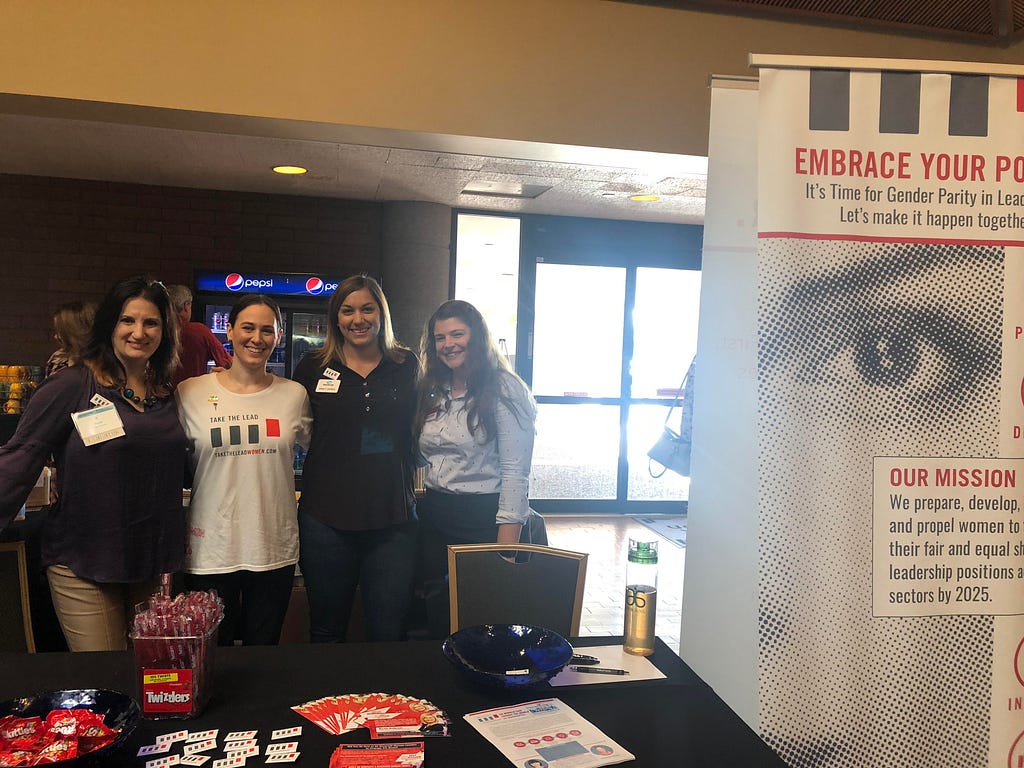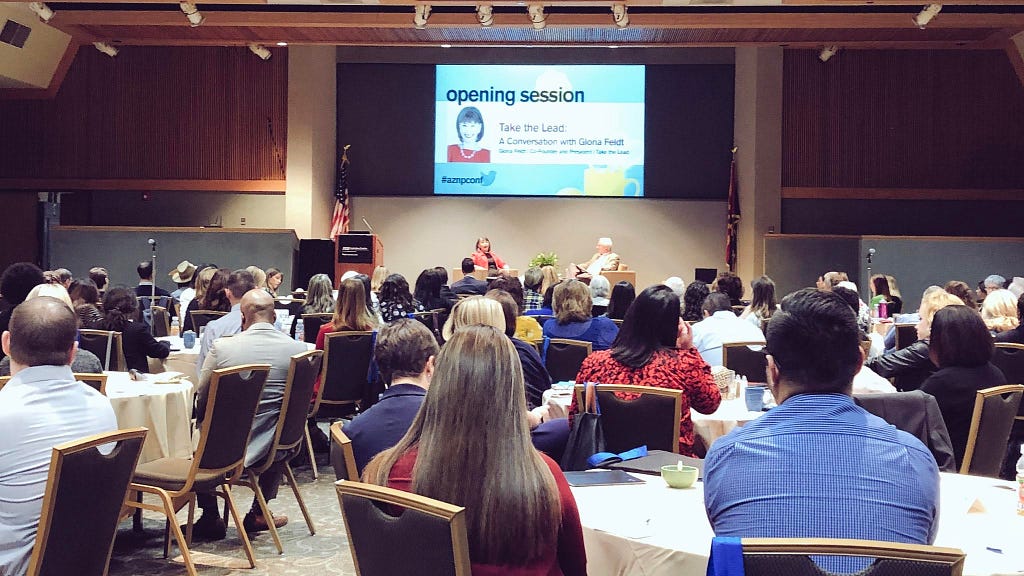5 Really Bad Strategic Mistakes Nonprofit Leaders Often Make


Issue 72 — October 28, 2018
Last week I was privileged to keynote the annual conference of Arizona State University’s Lodestar Center for Philanthropy and Nonprofit Innovation by being interviewed by the Center’s Executive Director Robert Ashcraft.
(A shout out here to the Center’s Nicole Anderson who organized the conference masterfully. If I may take a point of pride, she was a participant in Take The Leads 50 Women Can Change the World in Nonprofits program last year.)

Thanks to our intrepid Take The Lead AZ Leadership Council member K Royal and alumnae of our 50 Women Can Change the World in Nonprofits (You can apply here for the 2018 cohort.) Suzanne Sosnowski, Emily Denes, and Julie Euber, conference attendees learned about the transformational power of the program
Ashcraft had meticulously prepared for the conversation. He wryly commented that he knew more about me than I knew about myself. That unleashed my inner audaciousness.
Filters off, I let rip some observations I’ve made over four decades of doing nonprofit work. I’ve had a variety of titles — executive director, CEO, president — in nonprofit organizations from small to middle-sized to large, local to national. But in all cases, the buck stopped with me and that gave me a bird’s eye view of leadership and the nonprofit sector in general.

Little me on stage pontificating with Robert Ashcraft at the Lodestar Center nonprofit conference.
I could simply share the ASU Now article reporting on the lively discussion and be done with it. But after the conference, I kept thinking about the challenges I’d met, the mistakes I’d made, and the hard lessons I’d learned.
I’ve often compared nonprofit leadership to working in a for-profit business to the adage that Ginger Rogers did everything Fred Astaire did but she did it backward and in high heels. Nonprofit leaders are constantly scrutinized by their boards, the public, and often government entities. They usually must do their jobs with comparable skill levels to businesses but considerably fewer resources.
Those very realities often lead nonprofit leaders to make five really bad mistakes that can compromise the success of their organizations. And though these mistakes may seem like rational choices at the time, they can prevent the nonprofit from fulfilling its mission, becoming irrelevant, or losing public support.
Mistake #1: Losing focus on the mission. Take The Lead’s board chair, Dr. Nancy O’Reilly, has suggested that we should change the name to “social profit organizations.” That tweak of language could help us maintain focus on why your organization exist. After all, the purpose of the nonprofit sector is to solve social problems, and the mission of your organization should crisply define its purpose.
Yet the very structure of nonprofits with multiple funders and large volunteer boards of directors to whom the CEO must report can be conducive to mission creep. Resist the temptation to make everyone happy all the time. It takes a strong leader to nurture and guide the disparate stakeholders of a nonprofit organization to coalesce around a vision that remains true to the mission, even as strategies for advancing the mission may change over time due to changes in the marketplace, technology, or funding sources.
Mistake #2:Losing courage out of fear: fear of losing funding, fear of creating controversy, or fear of losing one’s job. Most nonprofit leaders come to their work with passion for the mission. Then they are faced with daily challenges large and small. So they may become timid, keep their heads down, and manage rather than lead. It’s not surprising that there will at times be actions taken that the board disagrees with, or events that create public or internal controversy. When you go forth to change the world, there will be pushback. That’s why I include helping leaders clarify their most deeply held values in our training.
I believe it’s essential to get to extreme clarity, to know when you would walk away or risk being fired rather than violate those values. Nothing is more liberating than having that clarity. It frees you to do a better job because it gives you the power to show up in your integrity. And most of the time, you discover that people follow people with courage and a clear point of view.
Mistake #3: Looking inward at the survival needs of the organization rather than outward to ask what the world needs. Inward focus is a recipe for failure at worst and mediocrity at best. A movement has to move. No movement or organization deserves to survive. You have to earn it every day by staying ahead of the curve, by doing what the world needs from the organization today. Power and energy come from projecting out into new spaces, not from standing still. Every perceived threat can become an opportunity to find a new way to serve your purpose. My 5th Leadership Power Tool is “Carpe the chaos.” Learn it and you will always be able to thrive while others struggle to survive.

The whole gang. L-r: Leadership Ambassador Mallary Tytel, conference honcho Nicole Anderson with other alumnae of the 50 Women programs Katie Thorson Wasson, yours truly, Carole Wymer, Jaime Fox, Emily Denes,
Lodestar Executive Director Robert Ashcraft, Suzanne Sosnowski
Mistake #4: Playing small. In my experience, the best strategy is always to grow out of a problem, not to contact when resources are tight. When I became president of Planned Parenthood Federation of America, it had a large deficit. The board’s response had been to cut programs while preserving the infrastructure. This might have seemed logical. But donors give to be part of exciting and ambitious programs that solve pressing social problems. They don’t give to maintain the Human Resources department, as necessary as that function may be. They want to feel part of something larger than themselves.
So I engaged the whole organization in creating a new vision for what we wanted to have accomplished in 25 years. Thinking that far ahead allowed people to let go of what was worrying them at the moment. They could think expansively, proactively, and boldly. Pretty soon, donors began to return and we almost doubled the budget. A new energy was breathed into the organization.

A great audience!
Never shrink your most effective programs. Figure out how to expand them. Find innovative solutions to the problems your movement was created to solve. Granted, moments of challenge can be opportunities to prune programs that are not measurably advancing your mission. But make those choices intentionally to create space to play big.
Mistake #5: Failure to close up shop if the mission has become irrelevant, or else become relevant again by revising the mission.
You never want merely to survive. That’s a losing game, guaranteed to result in getting nibbled away bit by bit. Either revitalize the mission or declare victory and move on. The March of Dimes was created to fight polio. To remain relevant, it retooled its mission to maternal and infant health after the Salk vaccine all but eliminated the disease.
Fear, risk aversion, inward focus, timidity, irrelevance. These are far bigger threats to nonprofits than all the funding cuts in the world.
Focus on mission, vision, values, growth, and creating solutions that address what the world needs from you now, and you will always be a successful nonprofit leader.
GLORIA FELDTis the New York Times bestselling author of several books including No Excuses: 9 Ways Women Can Change How We Think About Power, a sought-after speaker and frequent contributor to major news outlets, and the Co-Founder and President of Take The Lead. People has called her “the voice of experience,” and among the many honors she has been given, Vanity Fair called her one of America’s “Top 200 Women Legends, Leaders, and Trailblazers,” and Glamour chose her as a “Woman of the Year.” As co-founder and president of Take The Lead, a leading women’s leadership nonprofit, her mission is to achieve gender parity by 2025 through innovative training programs, workshops, a groundbreaking 50 Women Can Change The World immersive, online courses, a free weekly newsletter, and events including a monthly Virtual Happy Hour program and a Take The Lead Day symposium that reached over 400,000 women globally in 2017.
